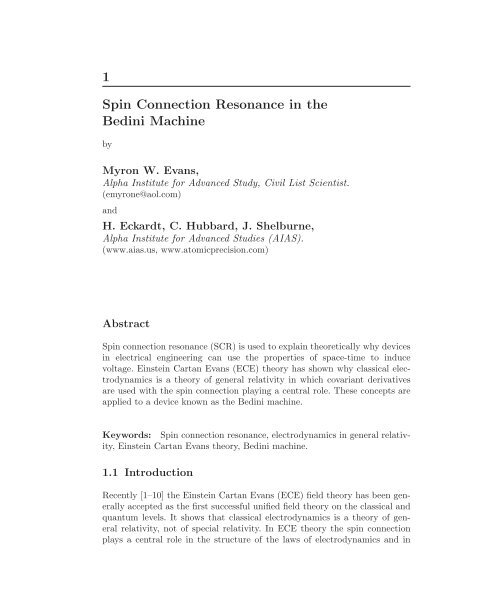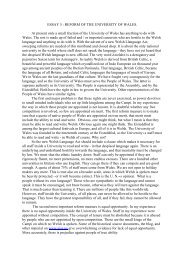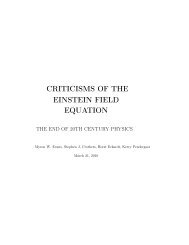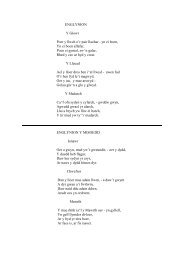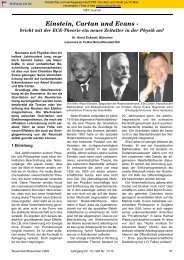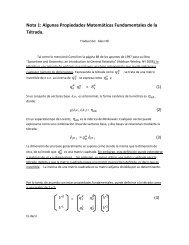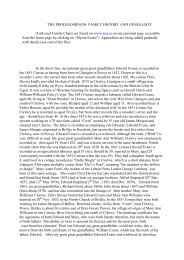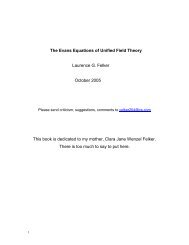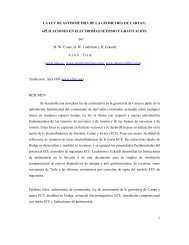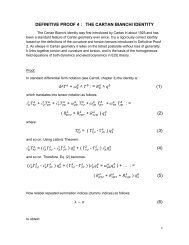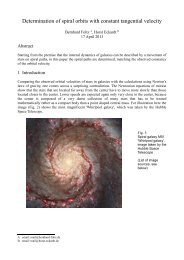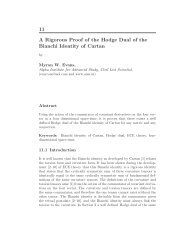Spin Connection Resonance in the Bedini Machine - Alpha Institute ...
Spin Connection Resonance in the Bedini Machine - Alpha Institute ...
Spin Connection Resonance in the Bedini Machine - Alpha Institute ...
Create successful ePaper yourself
Turn your PDF publications into a flip-book with our unique Google optimized e-Paper software.
1<br />
<strong>Sp<strong>in</strong></strong> <strong>Connection</strong> <strong>Resonance</strong> <strong>in</strong> <strong>the</strong><br />
Bed<strong>in</strong>i Mach<strong>in</strong>e<br />
by<br />
Myron W. Evans,<br />
<strong>Alpha</strong> <strong>Institute</strong> for Advanced Study, Civil List Scientist.<br />
(emyrone@aol.com)<br />
and<br />
H. Eckardt, C. Hubbard, J. Shelburne,<br />
<strong>Alpha</strong> <strong>Institute</strong> for Advanced Studies (AIAS).<br />
(www.aias.us, www.atomicprecision.com)<br />
Abstract<br />
<strong>Sp<strong>in</strong></strong> connection resonance (SCR) is used to expla<strong>in</strong> <strong>the</strong>oretically why devices<br />
<strong>in</strong> electrical eng<strong>in</strong>eer<strong>in</strong>g can use <strong>the</strong> properties of space-time to <strong>in</strong>duce<br />
voltage. E<strong>in</strong>ste<strong>in</strong> Cartan Evans (ECE) <strong>the</strong>ory has shown why classical electrodynamics<br />
is a <strong>the</strong>ory of general relativity <strong>in</strong> which covariant derivatives<br />
are used with <strong>the</strong> sp<strong>in</strong> connection play<strong>in</strong>g a central role. These concepts are<br />
applied to a device known as <strong>the</strong> Bed<strong>in</strong>i mach<strong>in</strong>e.<br />
Keywords: <strong>Sp<strong>in</strong></strong> connection resonance, electrodynamics <strong>in</strong> general relativity,<br />
E<strong>in</strong>ste<strong>in</strong> Cartan Evans <strong>the</strong>ory, Bed<strong>in</strong>i mach<strong>in</strong>e.<br />
1.1 Introduction<br />
Recently [1–10] <strong>the</strong> E<strong>in</strong>ste<strong>in</strong> Cartan Evans (ECE) field <strong>the</strong>ory has been generally<br />
accepted as <strong>the</strong> first successful unified field <strong>the</strong>ory on <strong>the</strong> classical and<br />
quantum levels. It shows that classical electrodynamics is a <strong>the</strong>ory of general<br />
relativity, not of special relativity. In ECE <strong>the</strong>ory <strong>the</strong> sp<strong>in</strong> connection<br />
plays a central role <strong>in</strong> <strong>the</strong> structure of <strong>the</strong> laws of electrodynamics and <strong>in</strong>
2 1 <strong>Sp<strong>in</strong></strong> <strong>Connection</strong> <strong>Resonance</strong> <strong>in</strong> <strong>the</strong> Bed<strong>in</strong>i Mach<strong>in</strong>e<br />
<strong>the</strong> way <strong>the</strong> electric and magnetic fields are related to <strong>the</strong> scalar and vector<br />
potentials. The ECE equations of classical electrodynamics allow <strong>the</strong> existence<br />
of resonances <strong>in</strong> potential which can be used to extract electric power<br />
from <strong>the</strong> structure of space-time. This structure is not <strong>the</strong> vacuum, <strong>the</strong> latter<br />
<strong>in</strong> relativity <strong>the</strong>ory is a universe devoid of all curvature and torsion. The<br />
resonance phenomenon <strong>in</strong>duced by <strong>the</strong>se equations is known as sp<strong>in</strong> connection<br />
resonance (SCR). In this paper it is applied to a device known as <strong>the</strong><br />
Bed<strong>in</strong>i mach<strong>in</strong>e [11], which has been patented and which has been shown to<br />
be experimentally reproducible and repeatable. In section 1.2 <strong>the</strong> equations<br />
of classical electrodynamics are given <strong>in</strong> ECE <strong>the</strong>ory. These are given <strong>in</strong> <strong>the</strong><br />
vector notation used by eng<strong>in</strong>eers, and <strong>the</strong> reduction of <strong>the</strong> orig<strong>in</strong>al differential<br />
form equations of ECE <strong>the</strong>ory to <strong>the</strong> vector equations is given <strong>in</strong> technical<br />
appendices. In section 3 models of <strong>the</strong> Bed<strong>in</strong>i device are developed, <strong>in</strong> section<br />
1.4 <strong>the</strong> occurrence of resonances is identified and graphed us<strong>in</strong>g computer<br />
algebra to check <strong>the</strong> derivations.<br />
1.2 The Equations of Classical Electrodynamics <strong>in</strong><br />
General Relativity<br />
All electromagnetic devices of eng<strong>in</strong>eer<strong>in</strong>g are governed by <strong>the</strong>se equations,<br />
which are <strong>the</strong> generally covariant form of classical electrodynamics. Each<br />
device must be considered separately, and <strong>the</strong> general equations applied systematically<br />
to each device. The electric field <strong>in</strong> ECE <strong>the</strong>ory is def<strong>in</strong>ed <strong>in</strong><br />
general by <strong>the</strong> scalar and vector potentials and by <strong>the</strong> scalar and vector components<br />
of <strong>the</strong> sp<strong>in</strong> connection:<br />
E = − ∂A<br />
∂t − c∇φ − cω0 A + cφω. (1.1)<br />
Here φ is <strong>the</strong> scalar potential, A is <strong>the</strong> vector potential, ω 0 is <strong>the</strong> scalar part<br />
of <strong>the</strong> sp<strong>in</strong> connection and ω is <strong>the</strong> vector part of <strong>the</strong> sp<strong>in</strong> connection (see<br />
technical appendices). The Coulomb law <strong>in</strong> ECE <strong>the</strong>ory [1–10] is<br />
∇ · E = ρ<br />
ɛ0<br />
:= cµ0J 0<br />
(1.2)<br />
where ɛ0 is <strong>the</strong> vacuum permittivity and ρ is <strong>the</strong> scalar part of <strong>the</strong> <strong>in</strong>homogeneous<br />
charge current density of ECE <strong>the</strong>ory. The magnetic field <strong>in</strong> ECE<br />
<strong>the</strong>ory is def<strong>in</strong>ed by:<br />
and <strong>the</strong> Gauss law of magnetism is:<br />
B = ∇ × A − ω × A (1.3)<br />
∇ · B = µ0j 0<br />
(1.4)
1.2 The Equations of Classical Electrodynamics <strong>in</strong> General Relativity 3<br />
where j 0 is <strong>the</strong> scalar part of <strong>the</strong> homogeneous charge current density. The<br />
Faraday law of <strong>in</strong>duction <strong>in</strong> ECE <strong>the</strong>ory is:<br />
∇ × E + ∂B<br />
∂t = cµ0j (1.5)<br />
where j is <strong>the</strong> vector part of <strong>the</strong> homogeneous charge current density and <strong>the</strong><br />
Ampère Maxwell law is:<br />
∇ × B − 1<br />
c2 ∂E<br />
∂t = µ0J (1.6)<br />
where J is <strong>the</strong> vector part of <strong>the</strong> <strong>in</strong>homogeneous charge current density.<br />
The explanation of various devices that are reproducible and repeatable<br />
depends on <strong>the</strong> systematic application of <strong>the</strong>se general equations. It has been<br />
shown [1–10] that <strong>the</strong>y are resonance equations <strong>in</strong> general, so that a small<br />
driv<strong>in</strong>g term can produce a very large amplification of space-time effects<br />
through <strong>the</strong> <strong>in</strong>ter-mediacy of <strong>the</strong> sp<strong>in</strong> connection. Devices which f<strong>in</strong>d no explanation<br />
<strong>in</strong> <strong>the</strong> standard model can be expla<strong>in</strong>ed <strong>in</strong> this way. For example, we<br />
consider <strong>the</strong> Bed<strong>in</strong>i device [11] as one <strong>in</strong> which an electric pulse produced by<br />
<strong>the</strong> rate of change of a magnetic field is <strong>in</strong>duced <strong>in</strong> a generator. The electric<br />
field pulse produces a pulse of electrons <strong>in</strong> a battery [11] as controlled by Eqs.<br />
(1.1) and (1.2), from which:<br />
∇ · ∇φ + 1<br />
c<br />
∂<br />
∂t (∇ · A)+∇ · ω 0 A − ∇ · (φω) =−µ0J 0 . (1.7)<br />
This equation produces resonances <strong>in</strong> two ways, each of which gives a resonance<br />
equation.<br />
i.e.<br />
1. If it is assumed that <strong>the</strong> orig<strong>in</strong> of E is purely due to φ, we obta<strong>in</strong> <strong>the</strong><br />
basic resonance equations of paper 63 and 92 of <strong>the</strong> ECE series [1–10].<br />
2. If it is assumed that <strong>the</strong> orig<strong>in</strong> of E is purely magnetic, and that <strong>the</strong><br />
scalar potential is zero, we have:<br />
1<br />
c<br />
∂<br />
∂t (∇ · A)+∇ · ω 0 A = −µ0J 0 . (1.8)<br />
∇ ·<br />
<br />
1 ∂A<br />
c ∂t + ω0 <br />
A = −µ0J 0 . (1.9)
4 1 <strong>Sp<strong>in</strong></strong> <strong>Connection</strong> <strong>Resonance</strong> <strong>in</strong> <strong>the</strong> Bed<strong>in</strong>i Mach<strong>in</strong>e<br />
which can be <strong>in</strong>tegrated to give a resonance equation. It is also possible to<br />
produce a time dependent resonance equation from Eqs. (1.1) and (1.6). The<br />
Ampère Maxwell law (1.6) is considered to produce a driv<strong>in</strong>g term:<br />
∂E<br />
∂t = c2 (∇ × B − µ0J) driv<strong>in</strong>g = −∇ ∂φ<br />
∂t − ∂2A ∂t2 − ∂ 0 ∂<br />
cω A +<br />
∂t ∂t (cφω)<br />
so that <strong>the</strong> most general resonance equation of time-dependent type is:<br />
∂2A ∂A<br />
+ c∂ω0 A + cω0<br />
∂t2 ∂t ∂t<br />
= c∂φω<br />
+ cφ∂ω<br />
∂t ∂t + c2 µ0J<br />
− ∇ ∂φ<br />
∂t − c2∇ × B.<br />
If <strong>the</strong>re is no charge and current density this equation reduces to:<br />
(1.10)<br />
(1.11)<br />
∂2A ∂A<br />
+ cω0 + c∂ω0<br />
∂t2 ∂t ∂t A = −c2 (∇ × B) driv<strong>in</strong>g . (1.12)<br />
There is resonance <strong>in</strong> A under <strong>the</strong> follow<strong>in</strong>g conditions:<br />
1. <strong>the</strong> scalar part, ω 0 , of <strong>the</strong> sp<strong>in</strong> connection is non-zero,<br />
2. <strong>the</strong> time derivative, ∂ω0<br />
∂t , is non-zero,<br />
3. <strong>the</strong> curl ∇ × B is non-zero and also time dependent.<br />
When <strong>in</strong>vestigat<strong>in</strong>g various claims such as <strong>the</strong> Bed<strong>in</strong>i mach<strong>in</strong>e it is necessary<br />
to use equations such as this, which show for example that <strong>the</strong> magnetic<br />
field <strong>in</strong> <strong>the</strong> design must be both space and time dependent, and produced<br />
by a device that satisfies <strong>the</strong>se requirements. That is an example of a design<br />
prediction of ECE <strong>the</strong>ory <strong>in</strong> eng<strong>in</strong>eer<strong>in</strong>g.<br />
In addition to Eq. (1.6) <strong>the</strong>re exists <strong>the</strong> Coulomb law (1.2), which is <strong>the</strong><br />
resonance equation [1–10]: [1–10]<br />
<br />
∇ · cφω − ∇φ − ∂A<br />
∂t − cω0 <br />
A = ρ<br />
. (1.13)<br />
ɛ0<br />
In <strong>the</strong> absence of charge this equation reduces to:<br />
<br />
∂A<br />
∇ ·<br />
∂t + cω0 <br />
A = 0 (1.14)
1.2 The Equations of Classical Electrodynamics <strong>in</strong> General Relativity 5<br />
so ω 0 may be elim<strong>in</strong>ated between equations (1.12) and (1.14). Eq. (1.14) is:<br />
∇ · ∂A<br />
∂t = −c A · ∇ω 0 + ω 0 ∇ · A . (1.15)<br />
Therefore ω 0 is governed by Eqs. (1.12) and (1.15) which must be solved<br />
simultaneously. The latter equation can be <strong>in</strong>tegrated with <strong>the</strong> divergence<br />
<strong>the</strong>orem [12]. For any well behaved vector field V(r) def<strong>in</strong>ed with a volume<br />
surrounded by a closed surface S:<br />
Thus for <strong>the</strong> Coulomb law 1.12:<br />
i.e.<br />
<br />
<br />
S<br />
<br />
S<br />
<br />
V · n da =<br />
V<br />
V<br />
<br />
∇ · E − ρ<br />
E · n da = 1<br />
So <strong>the</strong> <strong>in</strong>tegration of Eq. (1.14) is:<br />
i.e.<br />
<br />
S<br />
<br />
S<br />
∂A<br />
∂t<br />
ɛ0<br />
ɛ0<br />
∇ · V d 3 r. (1.16)<br />
<br />
d 3 r = 0 (1.17)<br />
<br />
V<br />
ρ(r) d 3 r. (1.18)<br />
<br />
∂A<br />
∂t + cω0 <br />
A · n da = 0 (1.19)<br />
· n da = −c<br />
<br />
ω<br />
S<br />
0 A · n da. (1.20)<br />
Eq. (1.20) is a relation between ω 0 and A. The correct way of solv<strong>in</strong>g (1.12)<br />
is simultaneously with (1.18). This can be carried out numerically for various<br />
models of ∇ × B produced by various devices. It can be seen that ω 0 can<br />
be elim<strong>in</strong>ated and that Eq. (1.12) reduces to an undamped oscillator [1–10]<br />
because ∂A<br />
∂t is elim<strong>in</strong>ated <strong>in</strong> favour of A. So <strong>in</strong> this example A can be amplified<br />
to INFINITY for various models of ∇ · B act<strong>in</strong>g as a driv<strong>in</strong>g force. There is<br />
no need to model ω0 because it can be expressed <strong>in</strong> terms of A.
6 1 <strong>Sp<strong>in</strong></strong> <strong>Connection</strong> <strong>Resonance</strong> <strong>in</strong> <strong>the</strong> Bed<strong>in</strong>i Mach<strong>in</strong>e<br />
1.3 Systematic Evaluation of Equations for <strong>the</strong> Bed<strong>in</strong>i<br />
Mach<strong>in</strong>e<br />
If no scalar potential is present, <strong>the</strong> ECE field equations (1.1–1.6) <strong>in</strong> <strong>the</strong> base<br />
manifold take <strong>the</strong> simple form:<br />
with <strong>the</strong> def<strong>in</strong>ition equations<br />
∇ × E + ˙B = 0 (1.21)<br />
∇ × B − 1<br />
c 2 ˙E = 0 (1.22)<br />
∇ · B = 0 (1.23)<br />
∇ · E = 0 (1.24)<br />
B = ∇ × A − ω × A (1.25)<br />
E = − ˙A − cω 0 A. (1.26)<br />
Here <strong>the</strong> dot denotes <strong>the</strong> time derivative, A is <strong>the</strong> vector potential, ω <strong>the</strong><br />
vector sp<strong>in</strong> connection and ω 0 <strong>the</strong> scalar sp<strong>in</strong> connection, both <strong>in</strong> units of<br />
1/m. It is more convenient to transform <strong>the</strong> scalar sp<strong>in</strong> connection to a time<br />
frequency:<br />
ω0 := cω 0 . (1.27)<br />
Eqs. (1.21-1.24) represent a system of eight equations and by <strong>the</strong> right-hand<br />
side of Eqs. (1.25-1.26) seven variables are def<strong>in</strong>ed. In <strong>the</strong> most general case<br />
<strong>the</strong> scalar potential Φ is <strong>the</strong> eights variable so that (1.21)–(1.24) can be<br />
solved uniquely. Here we restrict consideration to <strong>the</strong> case without charges<br />
and <strong>the</strong>refore without a scalar potential.<br />
In classical electrodynamics we have <strong>the</strong> same equations, but without <strong>the</strong><br />
sp<strong>in</strong> connection. This leads to an <strong>in</strong>consistency for solv<strong>in</strong>g <strong>the</strong> equations.<br />
Sometimes solely <strong>the</strong> fields E and B are considered, <strong>the</strong>n only <strong>the</strong> equations<br />
(1.21)–(1.22) can be used. The Gauss and Coulomb law are tried to be handled<br />
as “constra<strong>in</strong>ts”, but this leads to an over-determ<strong>in</strong>ed equation system. In<br />
o<strong>the</strong>r cases (when charges and currents are present) <strong>the</strong> potentials A and
1.3 Systematic Evaluation of Equations for <strong>the</strong> Bed<strong>in</strong>i Mach<strong>in</strong>e 7<br />
Φ are taken as variables. Then only <strong>the</strong> Eqs. (1.22) and (1.24) can be used,<br />
<strong>the</strong> o<strong>the</strong>r two are homogeneous and lead to <strong>the</strong> trivial solution A =0.In<br />
contrast, ECE <strong>the</strong>ory presents a perfectly well-def<strong>in</strong>ed situation with eight<br />
equations and eight variables.<br />
There are basically two methods to comb<strong>in</strong>e <strong>the</strong>se equations to obta<strong>in</strong><br />
resonances for particular cases:<br />
1. use (1.21) and (1.22) completely to def<strong>in</strong>e driv<strong>in</strong>g terms, use (1.25) and<br />
(1.26) as basis for resonance solutions,<br />
2. use <strong>the</strong> terms ˙B, ˙E <strong>in</strong> (1.21), (1.22) as driv<strong>in</strong>g terms, <strong>in</strong>sert curl of (1.25)<br />
and (1.26) <strong>in</strong>to (1.21) and (1.22) and use <strong>the</strong>se equations for resonance<br />
solutions.<br />
We will see that both methods are not applicable <strong>in</strong> all possible cases.<br />
In addition to both methods, we have to use one of <strong>the</strong> equations (1.3),<br />
(1.4). The actual choice depends on <strong>the</strong> case if ω or ω0 occurs <strong>in</strong> <strong>the</strong> equations<br />
(1.21) and (1.22). In <strong>the</strong> follow<strong>in</strong>g we work out <strong>the</strong> dist<strong>in</strong>guished cases 1 and<br />
2 each for Eq. (1.21) (called sub-case a) and Eq. (1.22) (called sub-case b).<br />
1a: Faraday Law as driv<strong>in</strong>g term, B field resonance<br />
By def<strong>in</strong>ition we have<br />
(∇ × E)driv<strong>in</strong>g = −( ˙B)driv<strong>in</strong>g<br />
Insert<strong>in</strong>g <strong>the</strong> time derivative of (1.25) <strong>in</strong>to (1.28):<br />
∇ × ˙A − ˙ω × A − ω × ˙A =(˙B)driv<strong>in</strong>g = −(∇ × E)driv<strong>in</strong>g<br />
(1.28)<br />
(1.29)<br />
In order to obta<strong>in</strong> resonance a differential equation of second order <strong>in</strong> time is<br />
required, <strong>the</strong>refore we take a fur<strong>the</strong>r time derivative:<br />
∇ × Ä − ¨ω × A − 2 ˙ω × ˙A − ω × Ä =(¨B)driv<strong>in</strong>g<br />
(1.30)<br />
This is a resonance equation <strong>in</strong> A (for constant ω) as well as <strong>in</strong> ω (for<br />
constant A). The sp<strong>in</strong> connection can be obta<strong>in</strong>ed from simultaneously<br />
solv<strong>in</strong>g Eq. (1.23). This could be sufficient, if not all components of A or ω<br />
are different from zero. In <strong>the</strong> most general case fur<strong>the</strong>r equations have to be<br />
added.<br />
1b: Ampère-Maxwell Law as driv<strong>in</strong>g term, E field resonance<br />
In analogy to case 1a we obta<strong>in</strong> from (1.22):<br />
(∇ × B)driv<strong>in</strong>g = 1<br />
c 2 ( ˙E)driv<strong>in</strong>g<br />
(1.31)
8 1 <strong>Sp<strong>in</strong></strong> <strong>Connection</strong> <strong>Resonance</strong> <strong>in</strong> <strong>the</strong> Bed<strong>in</strong>i Mach<strong>in</strong>e<br />
and by apply<strong>in</strong>g (1.26):<br />
Ä + ω0A ˙ + ω0 ˙A = −( ˙E)driv<strong>in</strong>g<br />
(1.32)<br />
This is an equation for a damped resonance for ω0 > 0. The sp<strong>in</strong> connection<br />
can be determ<strong>in</strong>ed by comb<strong>in</strong><strong>in</strong>g (1.32) with (1.24).<br />
2a: B field def<strong>in</strong>ition as driv<strong>in</strong>g term, Faraday Law as resonance<br />
equation<br />
Tak<strong>in</strong>g <strong>the</strong> magnetic field <strong>in</strong> (1.21) as driv<strong>in</strong>g term gives<br />
Insert<strong>in</strong>g (1.26) <strong>in</strong>to (1.33):<br />
∇ × E = −( ˙B)driv<strong>in</strong>g. (1.33)<br />
∇ × ˙A + ∇ × (ω0A) =(˙B)driv<strong>in</strong>g<br />
or after tak<strong>in</strong>g a fur<strong>the</strong>r time derivative:<br />
∇ × Ä + ∇ × (˙ ω0A)+∇ × (ω0 ˙A) =(¨B)driv<strong>in</strong>g<br />
which is <strong>the</strong> equivalent of (1.30) with <strong>the</strong> o<strong>the</strong>r type of sp<strong>in</strong> connection.<br />
(1.34)<br />
(1.35)<br />
2b: E field def<strong>in</strong>ition as driv<strong>in</strong>g term, Ampère-Maxwell Law as<br />
resonance equation<br />
Start<strong>in</strong>g with Eq. (1.22) we obta<strong>in</strong><br />
and with (1.25):<br />
or<br />
∇ × B = 1<br />
c 2 ( ˙E)driv<strong>in</strong>g<br />
∇ × ∇ × A − ∇ × ω × A = 1<br />
c 2 ( ˙E)driv<strong>in</strong>g<br />
∇ (∇ · A) − ∇ 2 A − ω (∇ · A)+A (∇ · ω)<br />
− (A · ∇) ω +(ω · ∇) A = 1<br />
c 2 ( ˙E)driv<strong>in</strong>g.<br />
(1.36)<br />
(1.37)<br />
(1.38)<br />
This is a resonance equation for <strong>the</strong> space coord<strong>in</strong>ates of A. Investigat<strong>in</strong>g<br />
time-dependent resonances requires a twofold additional time derivation<br />
which makes this equation impractible.
1.4 Detailed Investigation of <strong>the</strong> Bed<strong>in</strong>i Mach<strong>in</strong>e 9<br />
1.4 Detailed Investigation of <strong>the</strong> Bed<strong>in</strong>i Mach<strong>in</strong>e<br />
1.4.1 Description of <strong>the</strong> Bed<strong>in</strong>i mach<strong>in</strong>e<br />
In <strong>the</strong> book “Free Energy Generation” [13], see also [14], Bed<strong>in</strong>i expla<strong>in</strong>s his<br />
battery charg<strong>in</strong>g device of 1984. He presents some variants of <strong>the</strong> mach<strong>in</strong>e<br />
constructed with<strong>in</strong> 20 years. The basic design has rema<strong>in</strong>ed <strong>the</strong> same. The<br />
patented Bed<strong>in</strong>i mach<strong>in</strong>e <strong>in</strong>ventor claims that his mach<strong>in</strong>es are able to extract<br />
energy from <strong>the</strong> surround<strong>in</strong>g space <strong>in</strong> <strong>the</strong> form of radiant energy. The authors<br />
here attempt to show that <strong>the</strong> energy produced by <strong>the</strong>se mach<strong>in</strong>es is <strong>the</strong><br />
result of disturb<strong>in</strong>g <strong>the</strong> local space-time unit volume, creat<strong>in</strong>g a resonance<br />
effect, which allows energy to flow out of <strong>the</strong> local unit volume, <strong>in</strong> <strong>the</strong> form of<br />
asymmetric electromagnetic wave forms <strong>in</strong>to a rectifier circuit, where it can<br />
be <strong>the</strong>n sent to a storage device. The ma<strong>the</strong>matical expressions developed<br />
are based on ECE field <strong>the</strong>ory. The result<strong>in</strong>g expressions will allow electrical<br />
designers to produce productive circuits, based on this math, s<strong>in</strong>ce <strong>the</strong> <strong>in</strong>ventor<br />
has not furnished an adequate explanation of <strong>the</strong> mach<strong>in</strong>es’ operation.<br />
One of <strong>the</strong> authors has replicated two of <strong>the</strong> Bed<strong>in</strong>i mach<strong>in</strong>es successfully,<br />
and o<strong>the</strong>rs have had success build<strong>in</strong>g and operat<strong>in</strong>g <strong>the</strong> mach<strong>in</strong>es.<br />
The Bed<strong>in</strong>i mach<strong>in</strong>e has several dist<strong>in</strong>ct elements (see Fig. 1.1). The <strong>in</strong>put<br />
power supply, which can be a battery or a rectified power supply from an<br />
external supply, provides <strong>the</strong> transducer coil and trigger circuitry with energy<br />
to pulse <strong>the</strong> unit volume through <strong>the</strong> trigger w<strong>in</strong>d<strong>in</strong>g. The magnet <strong>in</strong>duces<br />
an asymmetric pulse <strong>in</strong>to <strong>the</strong> transducer core, which <strong>in</strong>duces an e-m pulse <strong>in</strong><br />
Fig. 1.1. Bed<strong>in</strong>i mach<strong>in</strong>e (from [13], p. 47).
10 1 <strong>Sp<strong>in</strong></strong> <strong>Connection</strong> <strong>Resonance</strong> <strong>in</strong> <strong>the</strong> Bed<strong>in</strong>i Mach<strong>in</strong>e<br />
<strong>the</strong> trigger w<strong>in</strong>d<strong>in</strong>g, power w<strong>in</strong>d<strong>in</strong>g, and generator w<strong>in</strong>d<strong>in</strong>g. The trigger pulse<br />
causes power to flow <strong>in</strong>to <strong>the</strong> power w<strong>in</strong>d<strong>in</strong>g, giv<strong>in</strong>g a boot to <strong>the</strong> magnet as<br />
it goes on by, <strong>the</strong>reby power<strong>in</strong>g <strong>the</strong> rotor to <strong>the</strong> next magnet. The transducer<br />
pulse from <strong>the</strong> coils flows <strong>in</strong>to <strong>the</strong> unit volume, upsett<strong>in</strong>g <strong>the</strong> local field, and<br />
<strong>the</strong> result<strong>in</strong>g return energy is rectified after flow<strong>in</strong>g through <strong>the</strong> generator<br />
w<strong>in</strong>d<strong>in</strong>g.<br />
All of <strong>the</strong>se w<strong>in</strong>d<strong>in</strong>gs of <strong>the</strong> transducer are separate coils, wound concentrically<br />
on a spool, which has a core consist<strong>in</strong>g of mild iron rods, typically<br />
1/16” <strong>in</strong> diameter. Once <strong>the</strong> rotor is spun manually, and <strong>the</strong> power source<br />
and storage device are connected, <strong>the</strong> rotor will accelerate to a select speed<br />
determ<strong>in</strong>ed by a tun<strong>in</strong>g rheostat, and <strong>the</strong> mach<strong>in</strong>e will ma<strong>in</strong>ta<strong>in</strong> that speed<br />
<strong>in</strong>def<strong>in</strong>itely, charg<strong>in</strong>g <strong>the</strong> storage device, us<strong>in</strong>g less energy to run than it<br />
stores, <strong>the</strong>reby achiev<strong>in</strong>g over unity <strong>in</strong> its operation. One of <strong>the</strong> authors has<br />
determ<strong>in</strong>ed that <strong>the</strong> mach<strong>in</strong>e operates more efficiently at 24 Volts DC, than at<br />
12 Volts DC, and <strong>the</strong> mach<strong>in</strong>e operates at almost twice <strong>the</strong> rpm as compared<br />
to 12 Volt operation.<br />
Mr. Bed<strong>in</strong>i has built several demonstrator mach<strong>in</strong>es <strong>in</strong> <strong>the</strong> kilowatt size,<br />
however, one of <strong>the</strong> authors’ mach<strong>in</strong>es is only capable of 10-15 watts of output,<br />
but this size is adequate to provide mean<strong>in</strong>gful test results. One of <strong>the</strong> authors<br />
is presently build<strong>in</strong>g a larger mach<strong>in</strong>e to replicate Mr. Bed<strong>in</strong>i’s claims of higher<br />
power outputs. In addition to <strong>the</strong> rotor style mach<strong>in</strong>es, <strong>the</strong> <strong>in</strong>ventor has shown<br />
solid state designs, which <strong>the</strong> authors have not replicated yet, but o<strong>the</strong>rs<br />
have, with limited output success. A company us<strong>in</strong>g Mr. Bed<strong>in</strong>i’s designs is<br />
presently market<strong>in</strong>g a l<strong>in</strong>e of battery chargers claim<strong>in</strong>g to use radiant energy<br />
to enhance battery life and longevity.<br />
1.4.2 Models of <strong>the</strong> Bed<strong>in</strong>i mach<strong>in</strong>e<br />
Charg<strong>in</strong>g of a battery means a flow of ions <strong>in</strong> <strong>the</strong> electrolyte <strong>in</strong> direction<br />
reverse to <strong>the</strong> discharg<strong>in</strong>g current. Accord<strong>in</strong>g to <strong>the</strong> explanations of Bed<strong>in</strong>i,<br />
<strong>the</strong> battery charg<strong>in</strong>g process is evoked by high frequency pulses. This type of<br />
charg<strong>in</strong>g is completely different from <strong>the</strong> conventional DC charg<strong>in</strong>g process<br />
where <strong>the</strong> ion transport is effected by apply<strong>in</strong>g a DC voltage. Bed<strong>in</strong>i po<strong>in</strong>ts<br />
out that <strong>the</strong> high frequency / high voltage oscillations <strong>in</strong>itiate a coupl<strong>in</strong>g to<br />
spacetime so that <strong>the</strong> ions resonate and move <strong>in</strong> <strong>the</strong> direction opposite to<br />
<strong>the</strong> discharge current. No significant conventional recharg<strong>in</strong>g energy has to<br />
be expended <strong>in</strong> this process.<br />
Key of understand<strong>in</strong>g <strong>the</strong> process is <strong>the</strong> mechanism of tapp<strong>in</strong>g <strong>the</strong> vacuum<br />
background energy, i.e. to evoke a resonant coupl<strong>in</strong>g to <strong>the</strong> spacetime<br />
background. As has been shown by ECE field <strong>the</strong>ory [papers 63, 92], a coupl<strong>in</strong>g<br />
to spacetime background can be achieved by a resonance circuit. Such<br />
an orig<strong>in</strong>al circuit from Bed<strong>in</strong>i is shown <strong>in</strong> Fig. 1.1.<br />
The key component of <strong>the</strong> Bed<strong>in</strong>i mach<strong>in</strong>e is <strong>the</strong> trifilar wound coil which<br />
acts as a comb<strong>in</strong>ed transmitter-receiver transducer. In <strong>the</strong> follow<strong>in</strong>g we use <strong>the</strong><br />
work<strong>in</strong>g hypo<strong>the</strong>sis that <strong>the</strong> spacetime coupl<strong>in</strong>g takes place by means of this
1.4 Detailed Investigation of <strong>the</strong> Bed<strong>in</strong>i Mach<strong>in</strong>e 11<br />
coil. Therefore we need not consider <strong>the</strong> complex electro-chemical processes<br />
<strong>in</strong> <strong>the</strong> battery, and an electrical potential Φ can be omittet as already done<br />
<strong>in</strong> Equations (1.21–1.26).<br />
S<strong>in</strong>ce we have to model <strong>the</strong> fields of a cyl<strong>in</strong>drical coil, we choose cyl<strong>in</strong>der<br />
coord<strong>in</strong>ates (r, ϕ, z) for convenience with unit vectors er, eϕ, eZ as shown<br />
<strong>in</strong> Fig. 1.2. Inside a conventional coil <strong>the</strong> magnetic field is parallel to <strong>the</strong><br />
z direction and <strong>the</strong> vector potential is tangential to circles around B. We<br />
assume that <strong>the</strong> magnetic field ma<strong>in</strong>ta<strong>in</strong>s its direction <strong>in</strong> case of resonance.<br />
Then <strong>the</strong> vector sp<strong>in</strong> connection has to lie <strong>in</strong> <strong>the</strong> r-ϕ plane as well as A. In<br />
<strong>the</strong> simplest case it is perpendicular to A.<br />
Whe<strong>the</strong>r type a or b of setcion 3.1 should be chosen for model<strong>in</strong>g <strong>the</strong><br />
device, depends on <strong>the</strong> type of excitation mechanism. Inside <strong>the</strong> transducer<br />
we have<br />
(∇ × B) driv<strong>in</strong>g ≈ 0, (1.39)<br />
dur<strong>in</strong>g <strong>the</strong> puls<strong>in</strong>g phase. In <strong>the</strong> preced<strong>in</strong>g phase when a rotor-mounted magnet<br />
approaches <strong>the</strong> transducer, <strong>the</strong> mov<strong>in</strong>g magnet <strong>in</strong>duces a non-symmetric<br />
magnetic field with<strong>in</strong> <strong>the</strong> iron core of <strong>the</strong> transducer. Therefore condition<br />
(1.39) is not always valid. To obta<strong>in</strong> a viable model, we make <strong>the</strong> follow<strong>in</strong>g<br />
additional simplify<strong>in</strong>g assumptions. The B field is <strong>in</strong> z direction:<br />
B =<br />
⎛<br />
⎝ 0<br />
0<br />
BZ<br />
⎞<br />
⎠ . (1.40)<br />
The vector potential <strong>in</strong> classical electrodynamics <strong>the</strong>n has only a ϕ and r<br />
component:<br />
⎛<br />
A = ⎝<br />
Ar<br />
Aϕ<br />
0<br />
⎞<br />
⎠ . (1.41)<br />
Fig. 1.2. Cyl<strong>in</strong>drical coord<strong>in</strong>ate system and fields <strong>in</strong> a coil.
12 1 <strong>Sp<strong>in</strong></strong> <strong>Connection</strong> <strong>Resonance</strong> <strong>in</strong> <strong>the</strong> Bed<strong>in</strong>i Mach<strong>in</strong>e<br />
S<strong>in</strong>ce <strong>the</strong> sp<strong>in</strong> connection ω cannot be <strong>in</strong> parallel to A and B accord<strong>in</strong>g to<br />
Eq. (1.25), we choose<br />
⎛<br />
ω = ⎝ ωr<br />
ωϕ<br />
0<br />
⎞<br />
⎠ . (1.42)<br />
Due to <strong>the</strong> rotational symmetry of <strong>the</strong> device, <strong>the</strong>re cannot be a ϕ dependence<br />
of <strong>the</strong> fields. In total we have <strong>the</strong> functional dependencies<br />
BZ = BZ(r, t)<br />
Ar = Ar(r, t)<br />
Aϕ = Aϕ(r, t)<br />
ωr = ωr(r, t)<br />
ωϕ = ωϕ(r, t)<br />
ω0 = ω0(r, t)<br />
(1.43)<br />
With (1.40–1.42) we have (us<strong>in</strong>g <strong>the</strong> differential operators <strong>in</strong> cyl<strong>in</strong>der coord<strong>in</strong>ates)<br />
⎛<br />
∇ × A = ⎝<br />
⎛<br />
1<br />
r<br />
ω × A = ⎝<br />
0<br />
0<br />
∂<br />
∂r (rAϕ) − ∂Ar<br />
∂ϕ<br />
0<br />
0<br />
ωrAϕ − ωϕAr<br />
The divergence of a vector V is <strong>in</strong> cyl<strong>in</strong>dric coord<strong>in</strong>ates:<br />
∇ · V = 1<br />
r<br />
∂<br />
∂r<br />
(rVr)+ 1<br />
r<br />
∂<br />
∂ϕ<br />
⎞<br />
⎠ , (1.44)<br />
⎞<br />
⎠ . (1.45)<br />
(Vϕ)+ ∂<br />
∂z (VZ) . (1.46)<br />
We are now ready to apply <strong>the</strong> methods 1a, 1b, 2a. Start<strong>in</strong>g with 1a, we<br />
obta<strong>in</strong> from Eq. (1.30) with <strong>the</strong> special form of A and ω (1.40-1.45):<br />
1<br />
r<br />
From (1.23) follows<br />
∂<br />
∂r (rÄϕ) − ∂Är<br />
∂ϕ − ¨ωrAϕ +¨ωϕAr − 2( ˙ωr ˙ Aϕ − ˙ωϕ ˙ Ar)<br />
− ωr Äϕ + ωϕ Är =( ¨ BZ)driv<strong>in</strong>g<br />
(1.47)<br />
∇ · (∇ × A − ω × A) = 0 (1.48)
or<br />
1.4 Detailed Investigation of <strong>the</strong> Bed<strong>in</strong>i Mach<strong>in</strong>e 13<br />
<br />
∂ 1 ∂<br />
∂z r ∂r (rAϕ)<br />
<br />
− ωrAϕ + ωϕAr<br />
=0. (1.49)<br />
This equation is trivially fulfilled. Even if we additionally assume Ar = ωϕ =0<br />
we have one equation with two unknowns Aϕ and ωr so that no unique<br />
solution is obta<strong>in</strong>ed.<br />
Consider<strong>in</strong>g <strong>the</strong> alternative case 2a we get from Eq. (1.35):<br />
From Eq. (1.24) follows<br />
or<br />
1 ∂<br />
<br />
r<br />
r ∂r<br />
Äϕ + r ˙ω0Aϕ + rω0 ˙<br />
<br />
Aϕ<br />
− ∂<br />
<br />
Är +˙ω0Ar + ω0<br />
∂ϕ<br />
˙<br />
<br />
Ar =( ¨ BZ)driv<strong>in</strong>g.<br />
1<br />
r<br />
∂<br />
∂r<br />
(1.50)<br />
<br />
∇ · − ˙A − ω0A = 0 (1.51)<br />
<br />
r ˙<br />
<br />
Ar + rω0Ar<br />
+ 1<br />
r<br />
∂<br />
∂ϕ<br />
<br />
Aϕ<br />
˙ + ω0Aϕ = 0 (1.52)<br />
Accord<strong>in</strong>g to (1.43) Eqs. (1.50) and (1.52) can be simplified to<br />
1<br />
r<br />
∂<br />
∂r<br />
<br />
rÄϕ + rω0Aϕ ˙ + rω0 ˙<br />
<br />
Aϕ =( ¨ BZ)driv<strong>in</strong>g<br />
1<br />
r<br />
∂<br />
∂r<br />
(1.53)<br />
<br />
r ˙<br />
<br />
Ar + rω0Ar = 0 (1.54)<br />
These are two equations for three unknowns and not unique as before.<br />
F<strong>in</strong>ally we apply case 1b. This is different from <strong>the</strong> previous ones s<strong>in</strong>ce<br />
<strong>the</strong> electrical field is considered to be <strong>the</strong> driv<strong>in</strong>g term. From Eq. (1.32) we<br />
obta<strong>in</strong> <strong>the</strong> two equations<br />
Är +˙ω0Ar + ω0 ˙<br />
Ar = −( ˙<br />
Er)driv<strong>in</strong>g<br />
Äϕ +˙ω0Aϕ + ω0 ˙<br />
Aϕ = −( ˙<br />
Eϕ)driv<strong>in</strong>g<br />
(1.55)<br />
(1.56)
14 1 <strong>Sp<strong>in</strong></strong> <strong>Connection</strong> <strong>Resonance</strong> <strong>in</strong> <strong>the</strong> Bed<strong>in</strong>i Mach<strong>in</strong>e<br />
and from Eq. (1.24):<br />
or<br />
1<br />
r<br />
∂<br />
∂r<br />
<br />
r ˙<br />
<br />
Ar + rω0Ar = 0 (1.57)<br />
<br />
Ar<br />
˙ + ω0 + r ∂ω0<br />
<br />
∂Ar ˙ ∂Ar<br />
Ar + r + rω0<br />
∂r ∂r ∂r<br />
=0. (1.58)<br />
We see that <strong>the</strong> sp<strong>in</strong> connection is coupled to <strong>the</strong> radial part of <strong>the</strong> vector<br />
potential. This <strong>in</strong>dicates that <strong>the</strong> unit volume <strong>in</strong>teract<strong>in</strong>g with spacetime may<br />
be somewhat extended beyond <strong>the</strong> transducer. The occurrence of ˙E implies<br />
a non-vanish<strong>in</strong>g curl of B accord<strong>in</strong>g to (1.31).<br />
The result (1.57) can fur<strong>the</strong>r be simplified by apply<strong>in</strong>g <strong>the</strong> divergence <strong>the</strong>orem<br />
as expla<strong>in</strong>ed at <strong>the</strong> end of section 1.2. The surface <strong>in</strong>tegral of Eq. (1.19)<br />
is to be taken over <strong>the</strong> cyl<strong>in</strong>der surface of <strong>the</strong> model. The parts over <strong>the</strong> circular<br />
areas cancel out due to <strong>the</strong> assumed symmetry <strong>in</strong> z direction. For <strong>the</strong><br />
cyl<strong>in</strong>drical part <strong>the</strong> ϕ component of <strong>the</strong> vector potential is perpedicular to<br />
<strong>the</strong> surface normal and does not contribute anyth<strong>in</strong>g. The only contribut<strong>in</strong>g<br />
part is <strong>the</strong> radial component:<br />
<br />
V<br />
∇ · Ad 3 <br />
r =<br />
S<br />
( ˙<br />
Ar + ω0Ar)da = 0 (1.59)<br />
S<strong>in</strong>ce Ar and ω0 are <strong>in</strong>dependent on <strong>the</strong> <strong>in</strong>dividual surface po<strong>in</strong>ts, <strong>the</strong> <strong>in</strong>tegral<br />
can be evaluated trivially and results <strong>in</strong><br />
Ar<br />
ω0 = − ˙<br />
Ar<br />
. (1.60)<br />
The equations (1.55, 1.56, 1.60) are three equations for three unknowns Ar,<br />
Aϕ, ω0. This set of equations has to be solved numerically to provide guidance<br />
to designers <strong>in</strong> siz<strong>in</strong>g <strong>the</strong> transducer, design<strong>in</strong>g <strong>the</strong> trigger and power<br />
circuits, and predict<strong>in</strong>g power outputs. S<strong>in</strong>ce <strong>the</strong> unit volume is surrounded<br />
by <strong>the</strong> large number of unit volumes <strong>in</strong> a spherical configuration(<strong>the</strong> rest of<br />
space), <strong>the</strong> <strong>the</strong>oretical power <strong>in</strong>put to <strong>the</strong> mach<strong>in</strong>e transducer is limited by<br />
its conductor size and impedance seen look<strong>in</strong>g <strong>in</strong>to <strong>the</strong> transducer from <strong>the</strong><br />
space side.<br />
This paper discusses <strong>the</strong> Bed<strong>in</strong>i mach<strong>in</strong>e <strong>in</strong> particular, but <strong>the</strong> concept of<br />
a transducer act<strong>in</strong>g as a transmitter-receiver for power extraction from <strong>the</strong><br />
surround<strong>in</strong>g space should be applicable to o<strong>the</strong>r mach<strong>in</strong>e designs also.<br />
The <strong>in</strong>ventor has put forth a hypo<strong>the</strong>sis as to how his mach<strong>in</strong>es operate,<br />
which is non-conventional <strong>in</strong> its premise. The authors here suggest that<br />
<strong>the</strong> latest ECE <strong>the</strong>ory will provide a rational explanation to <strong>the</strong> mach<strong>in</strong>es’
1.4 Detailed Investigation of <strong>the</strong> Bed<strong>in</strong>i Mach<strong>in</strong>e 15<br />
operation, us<strong>in</strong>g conventional ma<strong>the</strong>matical notation, and recognized physical<br />
<strong>the</strong>ory.<br />
1.4.3 <strong>Resonance</strong> behaviour of <strong>the</strong> vector potential<br />
Without do<strong>in</strong>g any numerical calculations, we can demonstrate that resonance<br />
solutions for Eqs. (1.55, 1.56) exist. We assume a harmonic time dependence<br />
Ar = A1(r) s<strong>in</strong>(ωt) (1.61)<br />
ω0 = ω1(r) s<strong>in</strong>(ωt) (1.62)<br />
with a frequency ω (not to be confused with <strong>the</strong> sp<strong>in</strong> connection ω0) and<br />
radius dependent functions A1 and ω1. Let’s fur<strong>the</strong>r denote <strong>the</strong> right-hand<br />
side of (1.55) by f1, <strong>the</strong>n this equation can be written:<br />
For ωt = π/4 wehave<br />
and (1.63) simplifies to<br />
2A1ω1ω cos(ωt) s<strong>in</strong>(ωt) − A1ω 2 s<strong>in</strong>(ωt) =−f1. (1.63)<br />
s<strong>in</strong>(ωt) = cos(ωt) = 1<br />
√ 2<br />
A1<br />
which gives <strong>the</strong> solution for Ar:<br />
<br />
ω1ω − ω2<br />
<br />
√ = −f1<br />
2<br />
A1 =<br />
f1<br />
(1.64)<br />
(1.65)<br />
ω2 . (1.66)<br />
√ − ω1ω<br />
2<br />
There is resonance when <strong>the</strong> denom<strong>in</strong>ator approaches zero, i.e.<br />
ω1 = ω √ 2 . (1.67)<br />
If we had def<strong>in</strong>ed (1.61, 1.62) by <strong>the</strong> cos<strong>in</strong>e function, we had got <strong>the</strong> same<br />
value for ω0 with a negative sign. From this simple model we learn that <strong>the</strong><br />
sp<strong>in</strong> connection can assume both signs (<strong>in</strong> contrast to a real frequency) and<br />
show up sharp resonances for certa<strong>in</strong> phases of <strong>the</strong> time period. This is <strong>in</strong><br />
accordance with <strong>the</strong> experimental f<strong>in</strong>d<strong>in</strong>gs. From <strong>the</strong> orig<strong>in</strong>al Eqs. (1.55, 1.56)<br />
we would expect a damped oscillation, but <strong>the</strong>se equations are non-l<strong>in</strong>ear<br />
and <strong>the</strong>refore some unexpected results can occur, <strong>in</strong> this case an undamped<br />
oscillation.
16 1 <strong>Sp<strong>in</strong></strong> <strong>Connection</strong> <strong>Resonance</strong> <strong>in</strong> <strong>the</strong> Bed<strong>in</strong>i Mach<strong>in</strong>e<br />
1.4.4 Computation of <strong>the</strong> energy balance<br />
The <strong>the</strong>ory should provide a method to estimate <strong>the</strong> energy balance of <strong>the</strong><br />
Bed<strong>in</strong>i mach<strong>in</strong>e. Accord<strong>in</strong>g to <strong>the</strong> previous section it is assumed that <strong>the</strong><br />
excess energy comes from <strong>the</strong> spacetime processes <strong>in</strong> <strong>the</strong> extended unit volume,<br />
where <strong>the</strong>y are evoked by <strong>the</strong> transducer. So a calculation has to compare<br />
<strong>the</strong> energy density of <strong>the</strong> <strong>in</strong>put fields (E)driv<strong>in</strong>g or (B)driv<strong>in</strong>g to <strong>the</strong> energy of<br />
<strong>the</strong> total fields be<strong>in</strong>g present <strong>in</strong> <strong>the</strong> resonance case. The result may depend on<br />
whe<strong>the</strong>r we consider <strong>the</strong> energy of <strong>the</strong> force fields only or whe<strong>the</strong>r we <strong>in</strong>clude<br />
<strong>the</strong> effects on <strong>the</strong> spacetime potential A. In <strong>the</strong> first case we can def<strong>in</strong>e <strong>the</strong><br />
energy densities for <strong>in</strong>put and output:<br />
u<strong>in</strong> = ɛ0<br />
2 (E2 )driv<strong>in</strong>g + 1<br />
(B<br />
2µ0<br />
2 )driv<strong>in</strong>g, (1.68)<br />
uout = ɛ0<br />
2 E2 + 1<br />
B<br />
2µ0<br />
2 . (1.69)<br />
The result<strong>in</strong>g total energies <strong>the</strong>n are obta<strong>in</strong>ed by <strong>in</strong>tegrat<strong>in</strong>g over <strong>the</strong> unit<br />
volume and time:<br />
<br />
E<strong>in</strong> = u<strong>in</strong> d 3 rdt (1.70)<br />
<br />
Eout = uout d 3 rdt (1.71)<br />
and <strong>the</strong> “coefficient of performance” is<br />
COP = Eout<br />
. (1.72)<br />
E<strong>in</strong><br />
Alternatively, <strong>the</strong> output energy can be related to <strong>the</strong> spacetime potential.<br />
From <strong>the</strong> m<strong>in</strong>imal prescription of momentum density p<br />
p → p + eA (1.73)<br />
we can def<strong>in</strong>e <strong>the</strong> k<strong>in</strong>etic energy density of <strong>the</strong> field by<br />
u = e2 A 2<br />
2m<br />
(1.74)<br />
where m is <strong>the</strong> “mass” of <strong>the</strong> field volume. Accord<strong>in</strong>g to <strong>the</strong> de Broglie equation<br />
m = ω<br />
c 2<br />
(1.75)
1.4 Detailed Investigation of <strong>the</strong> Bed<strong>in</strong>i Mach<strong>in</strong>e 17<br />
<strong>the</strong> mass corresponds to a frequency ω. This leads to <strong>the</strong> expression<br />
u = uout = e2 c 2<br />
2ω A2 . (1.76)<br />
1.4.5 Analytical and numerical solutions<br />
The equations to be solved for <strong>the</strong> model we have developed (Eqs. 1.55, 1.56,<br />
1.60) read<br />
Är +˙ω0Ar + ω0 ˙ Ar = −f1<br />
Äϕ +˙ω0Aϕ + ω0 ˙ Aϕ = −f2<br />
Ar<br />
ω0 = − ˙<br />
Ar<br />
(1.77)<br />
(1.78)<br />
. (1.79)<br />
with driv<strong>in</strong>g terms f1(r) andf2(r). Instead of Eq. (1.79) we can alternatively<br />
use its orig<strong>in</strong>al form (1.58) without application of <strong>the</strong> divergence <strong>the</strong>orem:<br />
<br />
Ar<br />
˙ + ω0 + r ∂ω0<br />
<br />
∂Ar ˙ ∂Ar<br />
Ar + r + rω0 =0. (1.80)<br />
∂r ∂r ∂r<br />
The difference is that <strong>the</strong> orig<strong>in</strong>al form represents a differential equation<br />
<strong>in</strong> r while <strong>the</strong> r differentiation has vanished <strong>in</strong> <strong>the</strong> o<strong>the</strong>r form. Thus<br />
Eqs. (1.77–1.79) are only to be solved <strong>in</strong> <strong>the</strong> time doma<strong>in</strong> which is a great<br />
alleviation. In this case Eq. (1.79) can be <strong>in</strong>serted <strong>in</strong>to (1.77). Then all terms<br />
on <strong>the</strong> left cancel out, lead<strong>in</strong>g to <strong>the</strong> condition<br />
f1 =0. (1.81)<br />
Obviously this is a compatibility condition, <strong>in</strong>dicat<strong>in</strong>g that a driv<strong>in</strong>g force f1<br />
cannot be applied. The second Equation (1.78) can be solved analytically by<br />
computer algebra and gives <strong>the</strong> particular solution<br />
Aϕ = ω0 f2<br />
<br />
−ω0 t<br />
e<br />
ω0 t e<br />
ω0 ˙ω0 t − ˙ω0 + ω 2 0<br />
<br />
dt −<br />
1<br />
ω0 ˙ω0 t − ˙ω0 + ω 2 0<br />
<br />
dt<br />
(1.82)<br />
As already made plausible <strong>in</strong> section (1.4.3), this is a resonance equation if<br />
<strong>the</strong> denom<strong>in</strong>ator goes to zero. This means that resonances occur at solutions<br />
of <strong>the</strong> differential equation<br />
ω0 ˙ω0 t − ˙ω0 + ω 2 0 =0. (1.83)
18 1 <strong>Sp<strong>in</strong></strong> <strong>Connection</strong> <strong>Resonance</strong> <strong>in</strong> <strong>the</strong> Bed<strong>in</strong>i Mach<strong>in</strong>e<br />
Computer algebra gives for this equation <strong>the</strong> general solution<br />
ω0 t − log (ω0) =c (1.84)<br />
with a constant c. This is a transcendent equation for ω0. S<strong>in</strong>ce c is arbitrary,<br />
<strong>the</strong>re is an <strong>in</strong>f<strong>in</strong>ite number of resonances <strong>in</strong> <strong>the</strong> whole <strong>in</strong>terval of real numbers<br />
for ω0.<br />
All fur<strong>the</strong>r <strong>in</strong>vestigations are made by a numerical model. As we have<br />
seen by analys<strong>in</strong>g Eq. (1.77) <strong>the</strong> vector potential Ar can be chosen freely.<br />
Consider<strong>in</strong>g <strong>the</strong> Bed<strong>in</strong>i mach<strong>in</strong>e, such a radial component can only be created<br />
by an asymmetric disturbance of <strong>the</strong> field potential of <strong>the</strong> transducer coil.<br />
This is achieved by <strong>the</strong> magnets of <strong>the</strong> wheel pass<strong>in</strong>g <strong>the</strong> transducer. We<br />
model <strong>the</strong>se pulses by a s<strong>in</strong>oidal function:<br />
Ar(t) =A1 s<strong>in</strong> 6 (ωt) (1.85)<br />
with an arbitrary amplitude A1 and a time frequency ω. This function and<br />
its time derivative are shown <strong>in</strong> Figs. 1.3 and 1.4 for three frequencies. With<br />
this ansatz, Eq. (1.79) takes <strong>the</strong> form<br />
ω0(t) =−6 ωcot(ωt). (1.86)<br />
This function has vertical tangents where <strong>the</strong> values approach <strong>in</strong>f<strong>in</strong>ity, see<br />
Fig. 1.5 for a plot of |ω0| for three frequencies <strong>in</strong> a logarithmic scale. Consequently,<br />
<strong>the</strong> derivative shows also this behaviour (Fig. 1.6).<br />
Eq. (1.78) has been solved numerically for Aϕ. The driv<strong>in</strong>g force f2 was<br />
assumed to be <strong>in</strong> proportion to <strong>the</strong> “symmetry break<strong>in</strong>g” potential Ar. With<br />
ω0 hav<strong>in</strong>g <strong>the</strong> s<strong>in</strong>gular behaviour, <strong>the</strong> solution spans a remarkable order of<br />
magnitude and is vulnerable to numerical <strong>in</strong>stabilities. Therefore <strong>the</strong> solution<br />
was checked by <strong>in</strong>sert<strong>in</strong>g it back <strong>in</strong>to Eq. (1.78) and check<strong>in</strong>g for equality<br />
with f2. In all cases <strong>the</strong> equality was ma<strong>in</strong>ta<strong>in</strong>ed with<strong>in</strong> sufficient precision.<br />
The result (Fig. 1.7) shows giant resonance peaks over 15 orders of magnitude<br />
which occur <strong>in</strong> co<strong>in</strong>cidence with <strong>the</strong> structure of ω0. Obviously <strong>the</strong>se peaks<br />
correspond to <strong>the</strong> peak signals <strong>in</strong> <strong>the</strong> Bed<strong>in</strong>i mach<strong>in</strong>e. The time frequency is<br />
to be identified with <strong>the</strong> pass<strong>in</strong>g rate of <strong>the</strong> magnets over <strong>the</strong> transducer. To<br />
make comparison even more appropriate, <strong>in</strong> Fig. (1.8) <strong>the</strong> derivative of Aϕ is<br />
shown which should correspond to <strong>the</strong> <strong>in</strong>duced voltage<br />
U<strong>in</strong>d = − ˙<br />
Aϕ. (1.87)<br />
The structure is very similar to that of Aϕ itself.<br />
Next we have tested <strong>the</strong> dependence of <strong>the</strong> solution on <strong>the</strong> driv<strong>in</strong>g force<br />
f2. It results that Aϕ is practically <strong>in</strong>sensitive to <strong>the</strong> form of f2, provided <strong>the</strong><br />
value is different from zero where ω0 has its poles. It is even sufficient to take
A r (t)<br />
1<br />
0.8<br />
0.6<br />
0.4<br />
0.2<br />
1.4 Detailed Investigation of <strong>the</strong> Bed<strong>in</strong>i Mach<strong>in</strong>e 19<br />
Input Model A r (t)<br />
0<br />
0 0.005 0.01 0.015 0.02 0.025<br />
Fig. 1.3. Radial component of vector potential Ar for three frequencies f=50<br />
Hz, 90 Hz, 140 Hz.<br />
dA r /dt<br />
1500<br />
1000<br />
500<br />
0<br />
-500<br />
-1000<br />
t[s]<br />
Input Model dA r /dt<br />
-1500<br />
0 0.005 0.01 0.015 0.02 0.025<br />
t[s]<br />
Fig. 1.4. Time derivative ˙ Ar for three frequencies f=50 Hz, 90 Hz, 140 Hz.<br />
f 1<br />
f2<br />
f 3<br />
f 1<br />
f 2<br />
f 3
20 1 <strong>Sp<strong>in</strong></strong> <strong>Connection</strong> <strong>Resonance</strong> <strong>in</strong> <strong>the</strong> Bed<strong>in</strong>i Mach<strong>in</strong>e<br />
|omega 0 |<br />
1e+012<br />
1e+010<br />
1e+008<br />
1e+006<br />
10000<br />
100<br />
1<br />
Input Model |omega 0 |<br />
0 0.005 0.01 0.015 0.02 0.025<br />
Fig. 1.5. |ω0| for three frequencies f=50 Hz, 90 Hz, 140 Hz.<br />
|d omega 0 /dt|<br />
1e+015<br />
1e+014<br />
1e+013<br />
1e+012<br />
1e+011<br />
1e+010<br />
1e+009<br />
1e+008<br />
1e+007<br />
1e+006<br />
f1 f2 f3 100000<br />
0 0.005 0.01 0.015 0.02 0.025<br />
t[s]<br />
Input Model |d omega 0 /dt|<br />
Fig. 1.6. Time derivative | ω0| ˙ for three frequencies f=50 Hz, 90 Hz, 140 Hz.<br />
t[s]<br />
f 1<br />
f2<br />
f 3
|A phi |<br />
1e+030<br />
1e+020<br />
1e+010<br />
1<br />
1e-010<br />
1e-020<br />
1.4 Detailed Investigation of <strong>the</strong> Bed<strong>in</strong>i Mach<strong>in</strong>e 21<br />
Solution |A phi |<br />
1e-030<br />
0 0.005 0.01 0.015 0.02 0.025<br />
Fig. 1.7. Solution |Aϕ(t)| for three frequencies f=50 Hz, 90 Hz, 140 Hz.<br />
|dA phi /dt|<br />
1e+040<br />
1e+030<br />
1e+020<br />
1e+010<br />
1<br />
1e-010<br />
1e-020<br />
1e-030<br />
0 0.005 0.01 0.015 0.02 0.025<br />
t[s]<br />
Solution |dA phi /dt|<br />
Fig. 1.8. Time derivative | ˙<br />
Aϕ(t)| for three frequencies f=50 Hz, 90 Hz,<br />
140 Hz.<br />
t[s]<br />
f 1<br />
f2<br />
f 3<br />
f 1<br />
f2<br />
f 3
22 1 <strong>Sp<strong>in</strong></strong> <strong>Connection</strong> <strong>Resonance</strong> <strong>in</strong> <strong>the</strong> Bed<strong>in</strong>i Mach<strong>in</strong>e<br />
a spike pulse of one percent of <strong>the</strong> time period. Fig. 1.9 shows <strong>the</strong> result for<br />
a constant value of f2.<br />
S<strong>in</strong>ce <strong>the</strong> zero cross<strong>in</strong>g of Ar is essential for <strong>the</strong> resonances, we have modified<br />
Eq. (1.85) by add<strong>in</strong>g a constant value of 0.001, thus displac<strong>in</strong>g <strong>the</strong> curve<br />
of Fig. 1.3 by this value from zero. The result (Fig. 1.10) shows a far smaller<br />
resonance structure <strong>in</strong>dicat<strong>in</strong>g that resonances are very sensitive to <strong>the</strong> form<br />
of Ar via ω0.<br />
Next we <strong>in</strong>spect <strong>the</strong> development of <strong>the</strong> maximum amplitude. In Fig. 1.11<br />
<strong>the</strong> maximum difference over <strong>the</strong> first six time periods is plotted <strong>in</strong> dependence<br />
of <strong>the</strong> time frequency. Obviously <strong>the</strong> resonance is most dramatic for low<br />
frequencies. In <strong>the</strong> next figure (Fig. 1.12) <strong>the</strong> maximum amplitude difference<br />
was recorded over a constant simulated time of 0.1 sec. To avoid numerical<br />
<strong>in</strong>stabilities <strong>in</strong>ferred by <strong>the</strong> calculation we used a modified Ar <strong>in</strong>put value as<br />
discussed for Fig. 1.10 (shifted by 0.1 upwards, no zero cross<strong>in</strong>g). Solutions<br />
are stable <strong>in</strong> <strong>the</strong> low frequency range but <strong>the</strong>re are w<strong>in</strong>dows of unstability for<br />
higher frequencies. We argue that <strong>the</strong> differential equation (1.78) can show<br />
chaotic behaviour and must be carefully evaluated.<br />
F<strong>in</strong>ally we present <strong>the</strong> amount of transferred energy <strong>in</strong>tegrated over time.<br />
Accord<strong>in</strong>g to Eq. (1.76) this is proportional to<br />
t<br />
u(t) =<br />
0<br />
A 2 ϕ(t ′ )<br />
ω dt′ . (1.88)<br />
This term is represented <strong>in</strong> Fig. 1.13. S<strong>in</strong>ce Aϕ crosses zero at <strong>the</strong> resonances<br />
(remember that <strong>the</strong> modulus is shown <strong>in</strong> <strong>the</strong> figures), a considerable amount<br />
of energy is pushed back to <strong>the</strong> vacuum after hav<strong>in</strong>g been transferred to <strong>the</strong><br />
system, but <strong>the</strong>re is enough energy left after each resonance peak so that <strong>the</strong><br />
energy <strong>in</strong> <strong>the</strong> system rises considerably.<br />
As a last item <strong>in</strong> this section let us consider <strong>the</strong> radius dependence of <strong>the</strong><br />
fields which can not be determ<strong>in</strong>ed from Eqs. (1.77–1.79) as discussed above.<br />
Therefore let’s start from Eqs. (1.77) and (1.80):<br />
Är +˙ω0Ar + ω0 ˙<br />
Ar = −f1<br />
<br />
Ar<br />
˙ + ω0 + r ∂ω0<br />
<br />
∂Ar ˙ ∂Ar<br />
Ar + r + rω0<br />
∂r ∂r ∂r<br />
(1.89)<br />
= 0 (1.90)<br />
We will make an ansatz for Ar and compute <strong>the</strong> solution for ω0 which is<br />
compatible with this. We choose<br />
Ar = Ce −αr−iβt<br />
(1.91)
|dA phi /dt|<br />
1e+030<br />
1e+025<br />
1e+020<br />
1e+015<br />
1e+010<br />
100000<br />
1<br />
1e-005<br />
1.4 Detailed Investigation of <strong>the</strong> Bed<strong>in</strong>i Mach<strong>in</strong>e 23<br />
Solution |dA phi /dt|<br />
1e-010<br />
0 0.005 0.01 0.015 0.02 0.025<br />
Fig. 1.9. Time derivative | ˙<br />
Aϕ(t)| with f2 = 1 for three frequencies f=50 Hz,<br />
90 Hz, 140 Hz.<br />
|dA phi /dt|<br />
10000<br />
100<br />
1<br />
0.01<br />
0.0001<br />
1e-006<br />
1e-008<br />
1e-010<br />
0 0.005 0.01 0.015 0.02 0.025<br />
t[s]<br />
t[s]<br />
Solution |dA phi /dt|<br />
Fig. 1.10. Time derivative | ˙<br />
Aϕ(t)| with Ar shifted by 0.001 for three frequencies<br />
f=50 Hz, 90 Hz, 140 Hz.<br />
f 1<br />
f2<br />
f 3<br />
f 1<br />
f2<br />
f 3
24 1 <strong>Sp<strong>in</strong></strong> <strong>Connection</strong> <strong>Resonance</strong> <strong>in</strong> <strong>the</strong> Bed<strong>in</strong>i Mach<strong>in</strong>e<br />
Max. Delta Aphi (f)<br />
1e+016<br />
1e+015<br />
1e+014<br />
1e+013<br />
1e+012<br />
<strong>Resonance</strong> Diagram<br />
1e+011<br />
0 50 100 150 200 250 300<br />
Fig. 1.11. <strong>Resonance</strong> behaviour: amplitude of Aϕ after 6 periods of frequency<br />
f.<br />
Max. Delta Aphi (f)<br />
1e+040<br />
1e+035<br />
1e+030<br />
1e+025<br />
1e+020<br />
1e+015<br />
1e+010<br />
100000<br />
1<br />
1e-005<br />
0 2000 4000 6000 8000<br />
f[Hz]<br />
10000 12000 14000 16000<br />
f[Hz]<br />
<strong>Resonance</strong> Diagram<br />
Fig. 1.12. <strong>Resonance</strong> behaviour: maximum amplitude of Aϕ with<strong>in</strong> 0.1 sec<br />
runtime, Ar shifted by 0.1.
Integral A phi 2/omega<br />
1e+040<br />
1e+020<br />
1<br />
1e-020<br />
1e-040<br />
1.4 Detailed Investigation of <strong>the</strong> Bed<strong>in</strong>i Mach<strong>in</strong>e 25<br />
Radiated Energy<br />
f1 f2<br />
f3 1e-060<br />
0 0.005 0.01 0.015 0.02 0.025<br />
Fig. 1.13. Integral over radiated energy for three frequencies f=50 Hz, 90<br />
Hz, 140 Hz.<br />
which is a conventional approach for a radially decreas<strong>in</strong>g vector potential<br />
which oscillates <strong>in</strong> time with frequency β. Insert<strong>in</strong>g this <strong>in</strong>to Eq. (1.89) results<br />
<strong>in</strong> a differential equation for ω0 <strong>in</strong> <strong>the</strong> variable t:<br />
The solution of this equation is<br />
− β 2 −αr−iβ<br />
+ iω0 β − ˙ω0 e C = −f1<br />
ω0(t) =c(r) e iβt + iβ− f1t<br />
C eαr+iβt<br />
t[s]<br />
(1.92)<br />
(1.93)<br />
with a constant c(r) which is dependent on r <strong>in</strong> general. Insert<strong>in</strong>g (1.93) <strong>in</strong>to<br />
(1.90) yields<br />
which has <strong>the</strong> solution<br />
(iαβr− ω0 αr+˙ω0 r − iβ+ ω0) e −αr−iβt C = 0 (1.94)<br />
ω0(r) = c(t)<br />
r eαr + iβ. (1.95)<br />
S<strong>in</strong>ce both solutions (1.93) and (1.95) must be compatible, we have to assume<br />
c(r) =0. (1.96)
26 1 <strong>Sp<strong>in</strong></strong> <strong>Connection</strong> <strong>Resonance</strong> <strong>in</strong> <strong>the</strong> Bed<strong>in</strong>i Mach<strong>in</strong>e<br />
By comparison of both equations for ω0 (1.93 and 1.95) we f<strong>in</strong>d<br />
and f<strong>in</strong>ally<br />
c(t) =− f1 t t<br />
eiβ<br />
C<br />
(1.97)<br />
ω0(r) =− f1 t<br />
C eαr+iβ t + iβ. (1.98)<br />
We see that <strong>the</strong> sp<strong>in</strong> connection has a diverg<strong>in</strong>g behaviour <strong>in</strong> space as well<br />
as <strong>in</strong> time which is consistent with <strong>the</strong> results of <strong>the</strong> numerical model.<br />
1.4.6 Summary and discussion<br />
The Bed<strong>in</strong>i device has been analysed by analytical and numerical methods.<br />
Based on a model of cyl<strong>in</strong>drical symmetry of <strong>the</strong> transducer, which is considered<br />
to be <strong>the</strong> essential part for spacetime coupl<strong>in</strong>g, <strong>the</strong> follow<strong>in</strong>g mechanism<br />
of spacetime <strong>in</strong>teraction could be identified:<br />
Under undisturbed conditions, <strong>the</strong> magnetic field <strong>in</strong> <strong>the</strong> transducer is<br />
cyl<strong>in</strong>drically symmetric. The radial part of <strong>the</strong> vector potential must vanish<br />
due to <strong>the</strong> Gauss law. The pass<strong>in</strong>g magnets of <strong>the</strong> wheel distort <strong>the</strong> symmetry<br />
of <strong>the</strong> magnetic field <strong>in</strong> <strong>the</strong> transducer by <strong>in</strong>duc<strong>in</strong>g an asymmetric signal. This<br />
leads to a radial component of <strong>the</strong> vector potential which was not present<br />
before. The vector potential changes <strong>in</strong> time and <strong>the</strong>refore <strong>in</strong>duces an electric<br />
field. Consequently, <strong>the</strong> Coulomb law has to be fulfilled as an additional<br />
condition, <strong>in</strong> this case for a vanish<strong>in</strong>g charge density (<strong>the</strong> electric field is completely<br />
a radiated field). The ECE field equations show that for <strong>the</strong> Coulomb<br />
law <strong>the</strong> radial component of <strong>the</strong> vector potential has ei<strong>the</strong>r to be zero, or<br />
<strong>the</strong> scalar sp<strong>in</strong> connection must exist to compensate a non-vanish<strong>in</strong>g radial<br />
component of <strong>the</strong> vector potential. The latter case is fulfilled <strong>in</strong> <strong>the</strong> Bed<strong>in</strong>i<br />
device and leads to <strong>the</strong> observed resonant behaviour.<br />
A model has been developed which takes a timely vary<strong>in</strong>g radial vector<br />
potential Ar as a given <strong>in</strong>put. By means of <strong>the</strong> Coulomb law, a sp<strong>in</strong> connection<br />
ω0 is produced. The zero cross<strong>in</strong>gs of Ar lead to a s<strong>in</strong>gular value of <strong>the</strong> sp<strong>in</strong><br />
connection, lead<strong>in</strong>g <strong>in</strong> turn to very high values of <strong>the</strong> ϕ component of <strong>the</strong><br />
vector potential. These are <strong>the</strong> giant resonances which are strong enough<br />
<strong>in</strong> practice to transfer significant amounts of energy from spacetime to <strong>the</strong><br />
mach<strong>in</strong>e.<br />
For some spacetime resonance experiments it is reported that <strong>the</strong>re is a<br />
glow<strong>in</strong>g or fluorescent light effect around <strong>the</strong> apparatus when it is at resonance.<br />
At <strong>the</strong> same time <strong>the</strong> measured current of <strong>the</strong> driv<strong>in</strong>g mechanism
1.4 Detailed Investigation of <strong>the</strong> Bed<strong>in</strong>i Mach<strong>in</strong>e 27<br />
takes a m<strong>in</strong>imum. This can qualitatively be expla<strong>in</strong>ed by analyz<strong>in</strong>g <strong>the</strong> contributions<br />
of <strong>the</strong> ECE electric charge current density. It is given <strong>in</strong> general<br />
by<br />
J =( ˜ R ∧ A − ω ∧ ˜ F ) (1.99)<br />
(<strong>in</strong> short hand notation) for <strong>the</strong> Hodge duals of curvature ˜ R and <strong>the</strong> electromagnetic<br />
field ˜ F as well as <strong>the</strong> potential A. At sp<strong>in</strong> connection resonance, it<br />
may happen that <strong>the</strong> term ω ∧ ˜ F outweights <strong>the</strong> curvature term. Then <strong>the</strong><br />
charge current can become significantly smaller while <strong>the</strong> region of space has<br />
a high energy density due to <strong>the</strong> large sp<strong>in</strong> connection term. Obviously no<br />
“negative energy” is required to expla<strong>in</strong> <strong>the</strong> effect.<br />
The only experimental feature which cannot be directly related to our<br />
model is <strong>the</strong> required behaviour of <strong>the</strong> driv<strong>in</strong>g current. Accord<strong>in</strong>g to Bed<strong>in</strong>i,<br />
<strong>the</strong> motor pulse acts as driv<strong>in</strong>g force for <strong>the</strong> spacetime resonance and must<br />
be very short and sharp without oscillations. The model calculations showed<br />
that <strong>the</strong> form of <strong>the</strong> driv<strong>in</strong>g force is not important as long as it is different<br />
from zero at <strong>the</strong> diverg<strong>in</strong>g time positions of <strong>the</strong> sp<strong>in</strong> connection.<br />
Based on <strong>the</strong> results of this paper we can give some recommendations<br />
for fur<strong>the</strong>r <strong>in</strong>vestigations and improvements of <strong>the</strong> Bed<strong>in</strong>i design, under <strong>the</strong><br />
prerequisite that our model is correct:<br />
1. The vector potential Ar has to be provided <strong>in</strong> a way to have zero cross<strong>in</strong>gs.<br />
This could be enforced by position<strong>in</strong>g magnets with alternat<strong>in</strong>g<br />
polarity on <strong>the</strong> wheel.<br />
2. S<strong>in</strong>ce mechanical parts limit <strong>the</strong> lifetime of a device, a design without<br />
mov<strong>in</strong>g parts is desirable. The pr<strong>in</strong>ciples of <strong>the</strong> design can be reta<strong>in</strong>ed<br />
by replac<strong>in</strong>g <strong>the</strong> wheel by a rotat<strong>in</strong>g electromagnetic field (for example<br />
based on a three-phase AC voltage). Then arbitrary rotation frequencies<br />
can be applied without mechanical restrictions.<br />
3. Effects of <strong>the</strong> asymmetry of <strong>the</strong> signal <strong>in</strong>duc<strong>in</strong>g <strong>the</strong> resonance should<br />
be <strong>in</strong>vestigated. For example it could be tested if a l<strong>in</strong>ear motion of a<br />
magnet perpendicular to <strong>the</strong> transducer would evoke resonance effects<br />
too.
A<br />
Appendix 1: Reduction of Form Notation to<br />
Vector Notation<br />
In differential form notation <strong>the</strong> electromagnetic field <strong>in</strong> ECE <strong>the</strong>ory is:<br />
which <strong>in</strong> tensor notation is 1–10:<br />
The electromagnetic potential is:<br />
F a = d ∧ A a + ω a b ∧ A b<br />
(A.1)<br />
F a µν = ∂µA a ν − ∂νA a µ + ω a µbA b ν − ω a νbA b µ. (A.2)<br />
A a µ = A (0) q a µ<br />
where q a µ is a rank two mixed <strong>in</strong>dex tensor def<strong>in</strong>ed by:<br />
(A.3)<br />
V a = q a µV µ . (A.4)<br />
Here V a and V µ are four vectors <strong>in</strong> different frames of reference labeled a and<br />
µ <strong>in</strong> four dimensional space-time. Consider a particular example of Eq. (A.2):<br />
F 1 23 = ∂2A 1 3 − ∂3A 1 2 + ω 1 2bA b 3 − ω 1 3bA b 2. (A.5)<br />
Ei<strong>the</strong>r side of <strong>the</strong> equation <strong>the</strong>re are rank three tensors whose components<br />
must correspond to each o<strong>the</strong>r on both sides. Thus:<br />
F 1 23 =(∂2A3 − ∂3A2) 1 + ω2bA b 3 − ω3bA b 2<br />
1 . (A.6)<br />
Inside <strong>the</strong> brackets on <strong>the</strong> right hand side are anti-symmetric tensor components<br />
which correspond to <strong>the</strong> components of an axial vector (magnetic field)
Appendix 1: Reduction of Form Notation to Vector Notation 29<br />
or polar vector (electric field). The magnetic vector components are defied<br />
by:<br />
thus:<br />
B 1 i = 1<br />
2 ɛijkF 1 jk<br />
This is recognized as <strong>the</strong> X component:<br />
of <strong>the</strong> magnetic field:<br />
Similarly:<br />
(A.7)<br />
B 1 1 = 1<br />
2 (ɛ123F23 + ɛ132F32) 1 = F 1 23. (A.8)<br />
BX = B 1 1<br />
(A.9)<br />
B = BXi + BY j + BZk. (A.10)<br />
BY = B 2 2 = F 2 31, (A.11)<br />
BZ = B 3 3 = F 3 12. (A.12)<br />
These results were checked by computer <strong>in</strong> paper 93 of <strong>the</strong> ECE series [1–10].<br />
So Eq. (A.6) becomes:<br />
In this notation:<br />
B = ∇ × A − ωb × A b . (A.13)<br />
<br />
ωb × A b<br />
X = ω3bA b 2 − ω2bA b1 3<br />
(A.14)<br />
where <strong>the</strong> m<strong>in</strong>us sign has been <strong>in</strong>troduced follow<strong>in</strong>g <strong>the</strong> usage of previous<br />
papers.<br />
These results are obta<strong>in</strong>ed <strong>in</strong> <strong>the</strong> special case:<br />
a = µ (A.15)<br />
<strong>in</strong> Eq. (A.4). This means that <strong>the</strong> vectors V a and V µ are written <strong>in</strong> <strong>the</strong> same<br />
frame of reference. Thus q a µ is diagonal <strong>in</strong> this special case:<br />
V 0 = q 0 0V 0 , V 1 = q 1 1V 1 , V 2 = q 2 2V 2 , V 3 = q 3 3V 3 , (A.16)
30 Appendix 1: Reduction of Form Notation to Vector Notation<br />
and from Eq. (A.3), A a µ must be diagonal also. So <strong>in</strong> Eq. (A.14)<br />
Similarly:<br />
<br />
ωb · A b<br />
X = ω32A 2 2 − ω23A 31 1<br />
3 = ω32A 2 2 − ω 1 23A 3 3. (A.17)<br />
ωb × A b<br />
Y = ω2 13A 3 3 − ω 2 31A 1 1, (A.18)<br />
ωb × A b<br />
Z = ω3 21A 1 1 − ω 3 12A 2 2. (A.19)<br />
Therefore <strong>the</strong> mean<strong>in</strong>g of <strong>the</strong> b <strong>in</strong>dex is given by Eqs. (A.17) to (A.19). The<br />
f<strong>in</strong>al result is:<br />
B = ∇ × A − ω × A (A.20)<br />
as used <strong>in</strong> previous papers on SCR [1]- [10]. The sp<strong>in</strong> connection has been<br />
reduced here to a vector ω. The components of this vector <strong>in</strong> analogy with<br />
Eqs. (A.9) to (A.12) are:<br />
So:<br />
ωX = ω 1 1 = ω 1 32 = −ω 1 23, (A.21)<br />
ωY = ω 2 2 = ω 2 31 = −ω 2 13, (A.22)<br />
ωZ = ω 3 3 = ω 3 12 = −ω 3 21. (A.23)<br />
ω = ωXi + ωY j + ωZk. (A.24)<br />
F<strong>in</strong>ally if we adopt <strong>the</strong> complex circular basis [1]- [10]:<br />
and if:<br />
we obta<strong>in</strong> <strong>the</strong> B (3)∗ sp<strong>in</strong> field:<br />
B (3)∗ = ∇ × A (3)∗ − iω (1) × A (2)<br />
ω (1) = gA (1)<br />
(A.25)<br />
(A.26)<br />
B (3)∗ = −igA (1) × A (2) . (A.27)
B<br />
Appendix 2: Derivation of <strong>the</strong> Electric Field <strong>in</strong><br />
Vector Notation<br />
For <strong>the</strong> electric field we consider:<br />
F i 0i =(∂0Ai − ∂iA0) 1 + ω i 0iA i i − ω i i0A 0 0, i =1, 2, 3 (B.1)<br />
which is equivalent <strong>in</strong> vector notation to:<br />
Therefore<br />
and<br />
Thus:<br />
E = −∇φ − ∂A<br />
∂t − cω0 A + cφω. (B.2)<br />
<br />
− ∇φ + ∂A<br />
<br />
∂t<br />
<br />
− ∇φ + ∂A<br />
<br />
∂t<br />
<br />
− ∇φ + ∂A<br />
<br />
∂t<br />
X<br />
− cω 0 A − cφω <br />
Y<br />
Z<br />
=(∂0A1 − ∂1A0) 1 , (B.3)<br />
=(∂0A2 − ∂2A0) 2 , (B.4)<br />
=(∂0A3 − ∂3A0) 3 , (B.5)<br />
X = ω1 01A 1 1 − ω 1 10A 0 0, (B.6)<br />
− cω 0 A − cφω <br />
Y = ω2 02A 2 2 − ω 2 20A 0 0, (B.7)<br />
− cω 0 A − cφω <br />
Z = ω3 03A 3 3 − ω 3 30A 0 0. (B.8)<br />
A = AXi + AY j + AZk. (B.9)
32 Appendix 2: Derivation of <strong>the</strong> Electric Field <strong>in</strong> Vector Notation<br />
where<br />
and<br />
where<br />
AX = A 1 1, AY = A 2 2, AZ = A 3 3. (B.10)<br />
ω = ωXi + ωY j + ωZk. (B.11)<br />
ωX = ω 1 10, ωY = ω 2 20, ωZ = ω 3 30. (B.12)<br />
The scalar part of <strong>the</strong> sp<strong>in</strong> connection is def<strong>in</strong>ed by:<br />
and <strong>the</strong> scalar potential is def<strong>in</strong>ed by:<br />
cω 0 = −ω 1 01 = −ω 2 02 = −ω 3 03<br />
(B.13)<br />
cφ = −A 0 0. (B.14)<br />
So <strong>the</strong> electric and magnetic field <strong>in</strong> general relativity (ECE <strong>the</strong>ory) are:<br />
E = −∇φ − ∂A<br />
∂t − cω0 A + cωφ. (B.15)<br />
B = ∇ × A − ω × A. (B.16)
References<br />
[1] M. W. Evans, “Generally Covariant Unified Field Theory” (Abramis, Suffolk,<br />
2005 onwards), volumes one to four, volume five <strong>in</strong> prep. (Papers 71 to 93 on<br />
www.aias.us).<br />
[2] L. Felker. “The Evans Equations of Unified Field Theory” (Abramis, Suffolk,<br />
2007).<br />
[3] K. Pendergast, “Crystal Spheres” (Abramis to be published, prepr<strong>in</strong>t on<br />
www.aias.us, 2008).<br />
[4] M. W. Evans, Acta Phys. Polonica, 38, 2211 (2007).<br />
[5] M. W. Evans and H. Eckardt, Physica B, 400, 175 (2007).<br />
[6] M. W. Evans, Physica B, 403, 517 (2008).<br />
[7] M. W. Evans, Omnia Opera of www.aias.us, 1992 to present.<br />
[8] M. W. Evans and H. Eckardt, Paper 63 of www.aias.us, published <strong>in</strong> volume<br />
four of ref. (1).<br />
[9] M. W. Evans, reviews <strong>in</strong> Adv. Chem. Phys., vols. 119(2) and 119(3) (2001).<br />
[10] M. W. Evans and L. B. Crowell, “Classical and Quantum Electrodynamics and<br />
<strong>the</strong> B(3) Field” (World Scientific, 2001); M. W. Evans and J.-P. Vigier, “The<br />
Enigmatic Photon” (Kluwer, Dordrect, 1994 to 2002, hardback and softback),<br />
<strong>in</strong> five volumes.<br />
[11] J. Bed<strong>in</strong>i, US patents on <strong>the</strong> Bed<strong>in</strong>i devices: US Patent No.<br />
6,392,370 (2002), 6,545,444 (2003), 20020097013 (2002), 20020130633<br />
(2002); <strong>in</strong>dustry certification test report (German TUV, 2002) under<br />
http://www.icehouse.net/john34/bed<strong>in</strong>ibearden.html.<br />
[12] E. G. Milewski, ed., “Vector Analysis Problem Solver” (Education Association,<br />
New York, 1984).<br />
[13] J. Bed<strong>in</strong>i and T. E. Bearden, “Free Energy Generation”, Cheniere Press, 2006.<br />
[14] http://tech.groups.yahoo.com/group/Bed<strong>in</strong>i Monopole.


